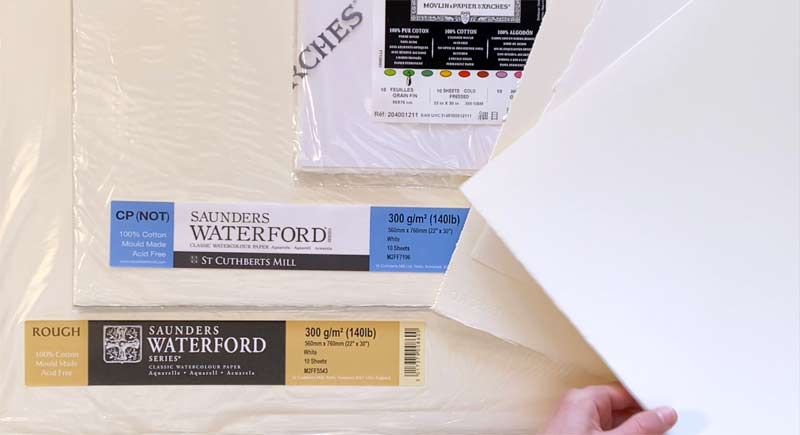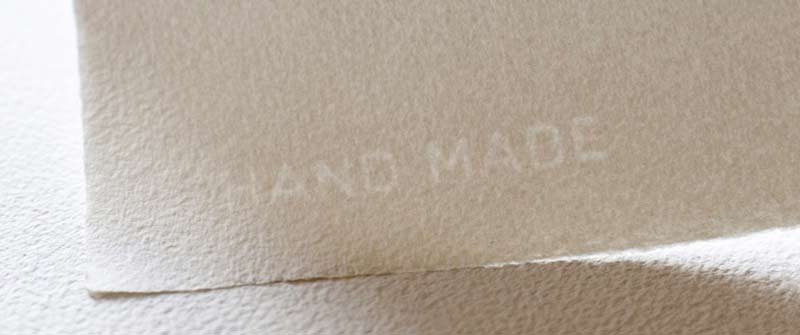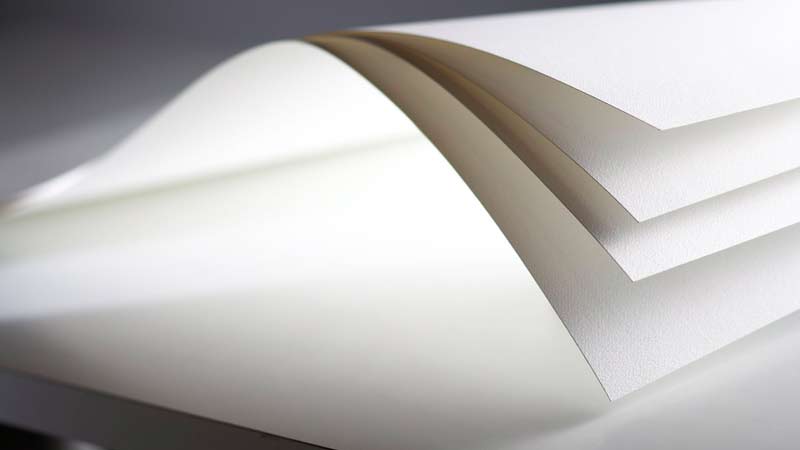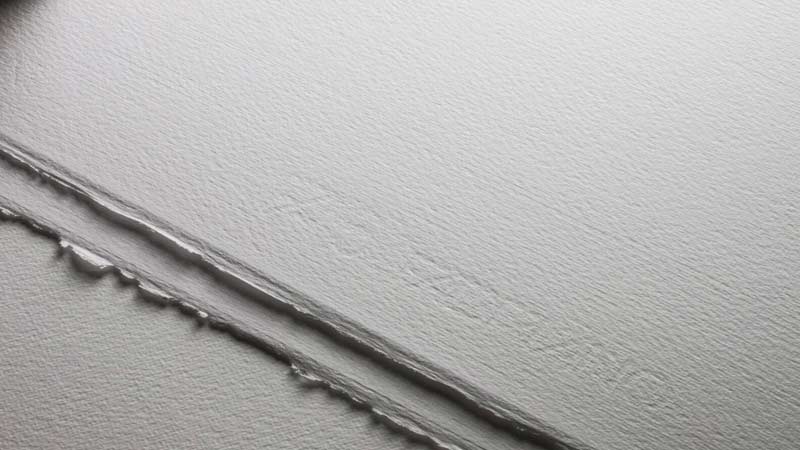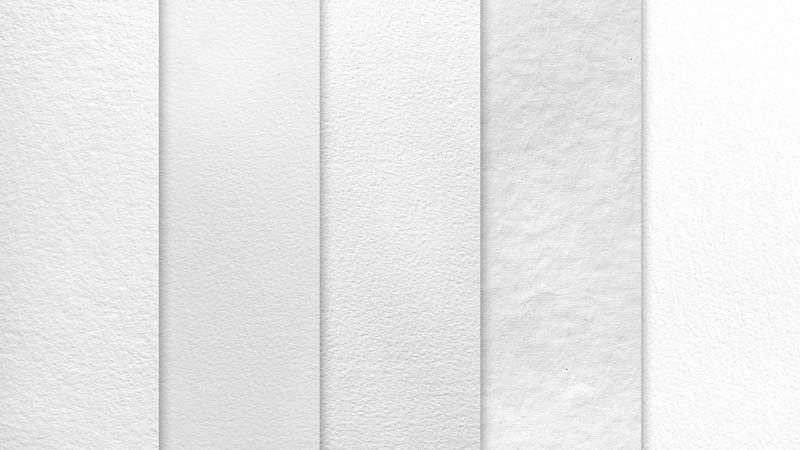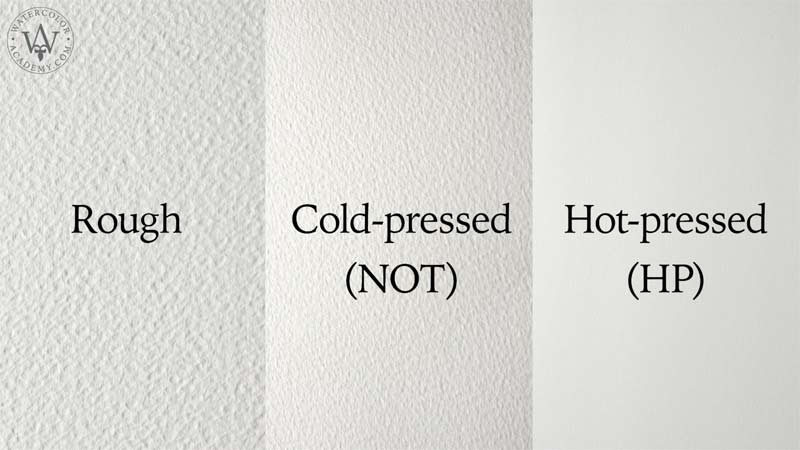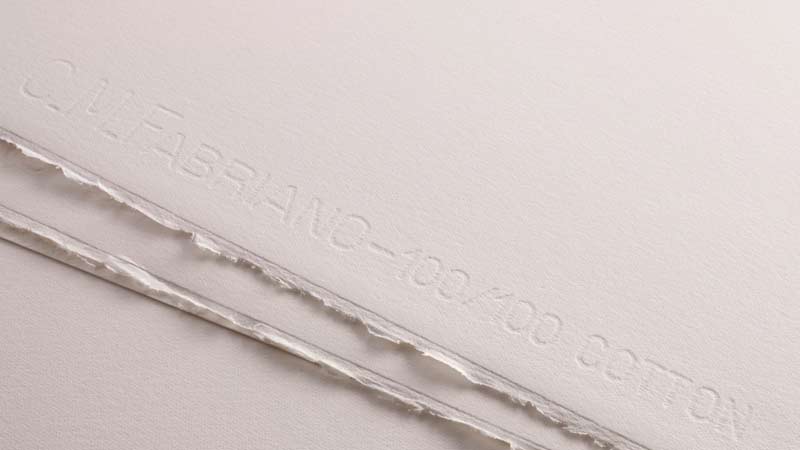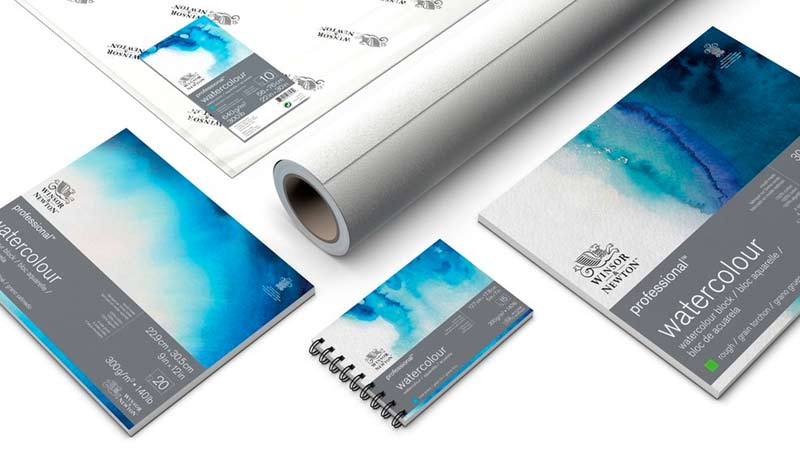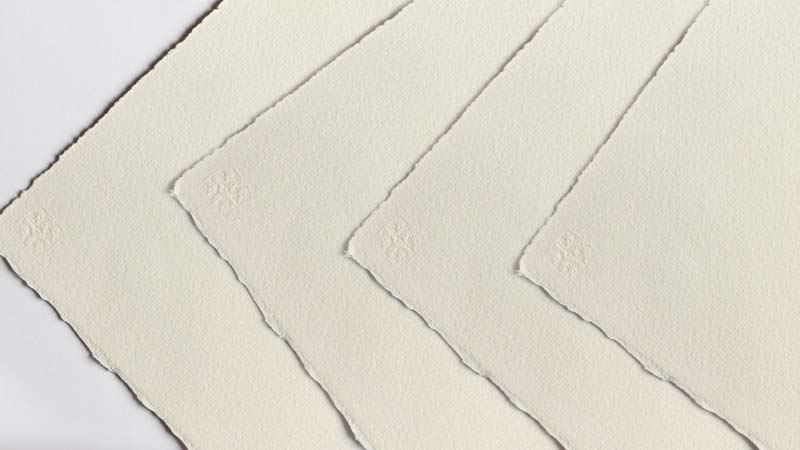Art Materials - Watercolor Paper
Article by Vladimir London, Watercolor Academy tutor
Good quality paper is the most important art material in watercolor. That is why choosing the paper that works best for you is essential
When it comes to art supplies, today the life of the artist could not be easier with so many different manufacturers offering an endless range of paints, brushes, supports and other materials. Nevertheless, a beginner might find it overwhelming to make the best choice. Often, the decision is made based on budget, emotional impulse, or guesswork.
This article will give you the necessary information on what you should consider when shopping for watercolor art materials.
Before we begin with art supplies, I must make a disclaimer. The advice here is based on my experience, personal preference, extensive research, and common sense. I do not advocate any particular brands or manufacturers.
Other artists might have different preferences and this is totally fine. Otherwise, there would no need in so many choices on a market.
Let's begin with what you need to know about materials for watercolor.
Watercolor Paper
Good quality paper is the most important art material in watercolor. That is why choosing the paper that works best for you is essential.
Many Watercolor Academy students ask me what paper to buy, expecting me to give them the paper brand name, weight, texture, form, size, price and an online art store link.
I have to say that if your art teacher insists on a certain paper because "it's the best", take such advice very cautiously. The choice of paper depends on individual preferences, working habits and painting styles. Taking on such advice will limit you to someone else's criteria that are not necessarily adequate for your personal artistic needs.
Before I explain what qualities of paper to look for and how to test them, you have to be familiar with the key characteristics of watercolor paper. These are:
- Manufacturing methods
- What it's made of
- Quality grade
- Weight of paper
- Texture of the surface
- Tint of paper
- Paper format
- Shape and form
Manufacturing Methods
Watercolor paper is made in one of the following ways:
- Handmade (production speed is about 80 sheets per hour)
- Mold-made (200 sheets per hour)
- Machine-made (23,000+ sheets per hour)
The first two types are more durable and distort less under heavy washes, but considerable more expensive.
What it's Made of
Paper is made out of cellulose fibers, which was historically prepared from cotton or linen.
Some 500-year-old drawings remain in better condition today than some artworks from the second half of the 18th and the 19th centuries. This is because paper manufacturers "improved" production and profit margins by adding wood pulp, clays and other fillers to bulk it up and make it less expensive, as well as using chemicals and acids to make paper whiter.
The composition of paper will command its durability and permanence. Aim for 100% cotton paper. Some manufactures make "rag paper" claiming it is cotton. Rags may be composed of some percentage of synthetic fibers and such paper may contain up to 80% of non-cotton fillers and wood. Pure cotton paper is strong and pliable; it will take paints well and be resistant to the mechanical damage of scraping, taping, masking, rubbing, etc.
Quality Grade
The best quality watercolor paper satisfies the following criteria:
- Made of pure cellulose fibers of cotton (or less often linen)
- Free of any synthetic fibers and wood lignin
- Does not contain clay or other fillers
- Free of acid with neutral acidity (pH)
All papers can be divided into two grades: that which meets the requirements listed above - artists' quality paper - and that which doesn't - the students' quality. Needless to say, you must go for the artists' quality.
The best quality paper - which will not yellow, contains no acids and will remain flexible for centuries - is also referred to as "archival paper".
Weight of Paper
"Weight of paper" indicates how heavy and therefore how thick it is. It does not indicate paper quality, however.
In the imperial system, the weight of paper is measured in pounds (lb) per 500 sheets (ream) and in metric system by grams per square meter (gsm).
Medium weight paper of 300gsm (140lb) provides good value for money compared to cheaper lightweight papers like 170gsm (80lb) that curl and buckle when wet and have to be stretched, or heavy weight of 600gsm (280lb) that is more like a board but twice as expensive.
Texture of the Surface
There are three types of surfaces:
- Rough
- Hot-pressed (HP)
- Cold-pressed (sometimes simply referred as "NOT", which means "not hot pressed")
As its name suggests, rough surface comes with a prominent tooth (texture); hot-pressed is smooth, hard and fine-grained; and cold-pressed is between the two.
The smoother paper is, the more its surface reflects light. This makes colors appear brighter and more saturated. The fine tooth of hot-pressed paper makes it easier to work in small details but it can give hard edges to brushstrokes and washes. Some artists find it more difficult to make broad washes on hot-pressed paper.
Rough paper is better suited for impressionistic styles and loose brushstrokes. Its non-pressed surface absorbs water very well, helping to achieve smooth washes; big tooth plays a pivotal role in granulated washes and adds interesting textural effects in dry-brush painting.
Cold-pressed papers are in the middle, acceptable both for smaller details and smooth washes. The middle-grained texture is easiest to paint on and more versatile for different painting styles.
Keep in mind that the size of grain differs between various brands.
Tint of Paper
In general, the whiter watercolor paper is, the better. Because no white pigment can be used in pure watercolor artwork, the natural tint of the paper is the lightest tone an artwork can have. Some paper is lighter than others. You also need to consider how the paper was bleached – either naturally (the preferred way) or with the use of chemicals and acids.
Paper Formats
Historical watercolor paper formats were derived from the British imperial system standardized in 1836. Here are some of the format names that you may encounter in old literature, although contemporary paper manufacturers may no longer use this terminology:
- Quarter Sheet – 11x15" (28x38cm)
- Half Sheet – 15x22" (38x56cm)
- Full Sheet (Imperial) – 22x30" (55x76cm)
There are also other sizes in between:
- Crown – 15x20" (38x51cm)
- Demy – 17.5x22.5" (44x57cm)
- Medium – 18x23" (46x58cm)
- Royal – 20x25" (51x64cm)
- Elephant (UK) – 20x27" (51x69cm)
- Super Royal – 20x28" (51x71cm)
- Single Elephant (USA) – 25.7x40" (64x102cm)
- Double Elephant (UK) – 27x40" (69x102cm)
- Double Elephant (USA) – 29x41" (74x104cm)
- Antiquarian – 31x53" (79x135cm)
- Emperor (USA) – 40x60" (102x152cm)
The ratio of those sizes varies from 1.25 to 1.71.
The metric system of paper sizes is based on the square-root-of-two ratio. If you are not into math, just skip the next paragraph where I will briefly describe the benefits of this system.
According to the ISO 216 standard, the ratio of paper size (the length divided by the width) is always constant and equal to the square root of two, which is approximately 1.4142. The biggest size is A0, measured 841x1189mm (33.1x46.8"): its area is equal to one square meter. Smaller sizes are attained by cutting previous size in half, so the width of a bigger sheet becomes the length of the smaller size sheet. A0 divided in half gives A1, which has 0.5 square meter area. A1 cut in half gives A2 with 0.25 m2, and so on till A10, which is as small as a post stamp. Such system is very handy when you need to glue two sheets into one and it becomes the larger-sized standard sheet without any trimming.
You will see the "Series A" sizes on paper blocks and pads:
- A1 – 594x841mm (23.4x33.1")
- A2 – 420x594mm (16.5x23.4")
- A3 – 297x420mm (11.7x16.5")
- A4 – 210x297mm (8.27x11.7")
- A5 – 148x210mm (5.83x8.27")
- A6 – 105x148mm (4.13x5.83")
Shape and Form
Watercolor paper is sold in individual sheets, rolls, blocks, pads, and sketchbooks.
The best quality watercolor paper is handmade and only available in individual sheets. One sheet may cost more than a whole block of students' quality paper. Sizes are often not standardized and there is a genuine deckle edge on all four sides. The deckle is a thinned stripe of cellulose that is left un-trimmed as an indication of the non-machine manufacturing process.
The mold-made papers that are sold in sheets might have two genuine deckle edges and two fake deckles along the sides where sheets have been cut from the roll.
Watercolor paper that is sold in rolls is often cheaper per square meter than individual sheets and can be up to 10 yards long and between 1 and 1.5 meter wide.
Watercolor blocks come in different sizes, anything between A2 and A5 and in stacks of 12 / 20 / 25 sheets. Sheets are bound with flexible glue on all four sides to a sturdy paperboard underneath and protected by a cover sheet on top. These blocks are advertised as "no stretching required", although paper will buckle when wet, especially under heavy washes on bigger formats. Smaller blocks are good for outdoor painting, while it is better to cut off and stretch bigger sheets for in-studio work. To prevent damage when separating the top sheet from the block you can insert a palette knife in the un-gummed area and slice along four sides. Watercolor blocks are more expensive per square meter than individual sheets.
Watercolor pads are similar to blocks but have only one side glued. It is tempting to simply peel sheets off by hand but like blocks, it is better to slice sheets off with a palette knife. Paper in pads is less expensive than in blocks because there is less gluing involves.
Sketchbooks for watercolor painting come in a wide array of sizes, bounds, weights, quality and number of pages per book. They are good for fast disposable artworks, preliminary sketches, travelling and outdoor painting. Get several sketchbooks but don't become a collector. Use them with the knowledge that the majority of the sketches won't be any good, you will only like some of them and you will only be proud enough of a few of them to show others.
It is erroneous to think that paper is less durable than a canvas or wooden support. Ask any restorer and you will be surprised to learn that many drawings, etchings and water-based paintings on paper created several hundred years ago are in much better condition today than equally old oil and tempera paintings on canvas and wooden boards. The majority of old masterpieces have suffered from decaying canvas and had to be transferred to a new support - a process called lining. Properly archived and stored artworks on paper are still as strong and bright as when they were created.
Every manufacturer of artists' quality watercolor paper claim that their product is one of the best. Unless you have a deep technical knowledge and have tested various papers from different brands, it is very hard to tell what paper is right for you. The majority of artists make "non-scientific" decisions based on marketing, what they have heard from other artists, brand reputation, price tag or an emotional impulse formed by paper size, weight, texture and color. There is, however, a more methodical approach to choosing watercolor paper.
Here is the list of 12 most important qualities good watercolor paper must have:
- Watercolor paper should be bright (either white or tinted) for translucent dried paint colors to be displayed accurately.
- It should not change the colors of paints by making them duller and should have minimal effect on color saturation when paints dry.
- It should take paints well without absorbing too much or blotching paints, floating them on the surface.
- It should be enjoyable to work on and attractive to look at.
- It should form strong bond between the fibers, the pigments and the binder of the paints.
- It should be responsive to different painting techniques – wet-in-wet, wet-on-dry, dry-brush, take multiple glazes, etc.
- It should be strong when wet.
- It should keep its size and not buckle or curl when wet.
- It should retain its original flat surface when it dries.
- It should resist physical damage both dry and wet when rubbing with eraser, wiping with a sponge, scraping, blotting, removing masking tape or masking liquid, etc.
- It should be lightfast and resistant to yellowing.
- It should be archival: it should keep the original colors of the paints and be resistant to the deterioration of fibers, keeping its flexibility with time.
You could say that it is useful to have an extensive list of "good-to-have" qualities, but how do you begin comparing different paper brands? There are some very simple tests you can do yourself that don't require any lab equipment. Here's how you can test watercolor paper:
- Shake the paper sheet and listen to how it sounds. A "metallic rattle" indicates well-processed paper pulp prior to casting, while a dull muffled sound reveals a not so well prepared pulp.
- Tear a strip off the sheet and check the edge. A fuzzy edge indicates short and even fibers, while a hairy and ragged edge shows that the fibers are longer and more irregular. Tear a strip along the adjacent side to check if the edge is any different; if so, the paper is most likely machine-made.
- To check the pulp composition, burn a strip of paper and check the ashes. Totally white completely burnt ash means that the paper is made of pure cotton or linen cellulose that was properly sized. Gray or dark ashes, or even unburned pieces, give away wood lignin, clays and additives or synthetic fibers.
- To check flexibility, fold and unfold paper. Brittle folds with crisp damage and memory tell that the quality is not premium.
- Look at the paper against strong light to check its thickness and density evenness.
- Compare paper color and brightness by placing two different brands against each other.
- Examine with a magnifying glass and by stroking with fingertips to compare the microscopic texture of the surface finish.
- To test lightfastness, place the paper under direct sunlight for at least two weeks to one month. Paper containing wood lignin will yellow.
- To examine absorbency, lick the paper surface. If it sticks to the tongue, it is probably too absorbent. Test absorbency further by applying water with a one-inch flat synthetic brush and check how long it takes for the paper to absorb the water completely.
- Cover the entire sheet with water using a big flat brush or a sponge to see how much the paper curls or cockles when wet and how flat it gets after drying.
- Check the resistance of dry paper to physical damage by scraping its surface (dry lifting), erasing graphite pencil marks with a rubber eraser. Check whether masking tape lifts off fibers, and its resistance to well-dried masking fluid removal.
- Check its resistance to damage when wet by blotting (wet lifting) - wiping off dried paint with wet synthetic brush to the point when paint is lifted off completely or surface is damaged. Do the same test using a sponge. When paper dries, apply a coat of paint to see how the surface responds to recoloring and how this top layer looks.
- Check for backruns to test surface sizing. Backruns appear when paint dries on the surface, meaning the paper is non-absorbent, hot pressed or is Bristol finished.
- And, of course, how the paper takes paints. Examine washes under sunlight to evaluate the color and brightness. Very absorbent papers will give dull, blotchy colors. Yellowing, off-white paper will dull green, blue or violet paints.
Artist's quality watercolor paper is double-sided and you can test each side. I know some artists who like to paint on the backside. Check the watermark or/and the chop to distinguish the sides.
A couple more tests (which require equipment) can be done to see how well paper and artwork will stand the test of time. Placing a piece of paper for 72 hours in an oven at a 90-degree temperature will reveal how brittle it would become after 1000 years under archival conditions. An adequate pH acidity test would also indicate how "friendly" paper is to acid-sensitive pigments.
Here's a list of some watercolor paper brands with good reputations in alphabetical order:
- Arches
- Fabriano
- Hahnemühle Aquarelle
- Hayle Mill
- Jack Richeson
- Saunders Waterford
- Twinrocker
- Velké Losiny
- Whatman
- Winsor & Newton
- Zerkall
If you are a complete beginner and have no previous experience, start with any good brand, 100% cotton, cold-pressed, acid-free watercolor paper with 300gsm (140lb) weight. Purchase a big-sized pad or individual sheets; you can always cut to a smaller size if required. Experiment and test different paper brands and types. Eventually, you will find what papers suit your personal painting style. With time your style will evolve and so might your paper choices.
Do not be tempted to save on paper by going for the cheapest options. Good paper tends to be expensive and good artwork that will survive hundreds of years requires a good support.
Watercolor Boards and Canvases
There are panels with watercolor paper or cotton canvas glued to a board, and primed boards that take watercolor paints like paper. All these options are more durable than paper and do not require any stretching but are considerably more expensive.
Here's a short list of boards to consider:
- Ampersand Aquaboard
- Fredrix Archival Watercolor Canvas Boards
- Crescent Premium Watercolor Board
If you want to experiment further, you could use wooden boards or stretched canvases for watercolor painting. This kind of support has to be primed with gesso and then coated with Absorbent Ground (Golden). Treated in this way, the surface becomes porous and absorbent, and will accept watercolor paint.
I would suggest you master watercolor painting techniques on paper before investing your time in experimenting with boards.
Drawing Paper
Apart from watercolor paper, you will also need drawing paper.
It is not advised to draw directly on watercolor paper. You must protect its white surface from any erasing, re-drawing, smudging or handling with unwashed hands. Instead, make your compositions and drawings on drawing paper first and then transfer your design to the watercolor sheet.
Any drawing paper would do, although you will find lighter weights are better suited to transferring over a light-box or window.
You could also consider purchasing a pad of tracing paper for transferring drawings on to watercolor sheets with a heavier weight.
To learn how to paint in watercolor, enroll now
Watercolor Academy Online Course
A self-study, self-paced course where you can learn how to paint in watercolor by watching video lessons and doing assignments
- Unlimited access to 80 watercolor painting video lessons
- Lifetime membership without deadlines
- Unlimited support from the Academy tutors
- Constructive critique of your artworks
- Member access to the Academy's Art community
- Place in the Academy's Students Gallery
- Exclusive members-only newsletter and bonuses
- Watercolor Academy Diploma of Excellence in your name
One-time payment - Lifetime membership
$297 USD
ENROLL NOW
Personal Tutoring online + Online Course
One-to-one, unlimited and custom-tailored to your skills and needs Personal Tutoring by the Watercolor Academy teachers
- Everything in Online Course, plus:
- Dedicated team of art tutors
- Assessment of your current level of art skills
- Personalized curriculum tailored to your skills and goals
- Up to 100 art tasks with by-task assessment
- Unlimited one-to-one personal coaching with detailed per-task instructions and feedback
- Artwork critiques and results-oriented guidance
One-time payment - Lifetime membership
$997 USD
ENROLL NOW

